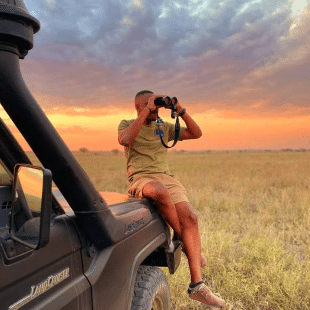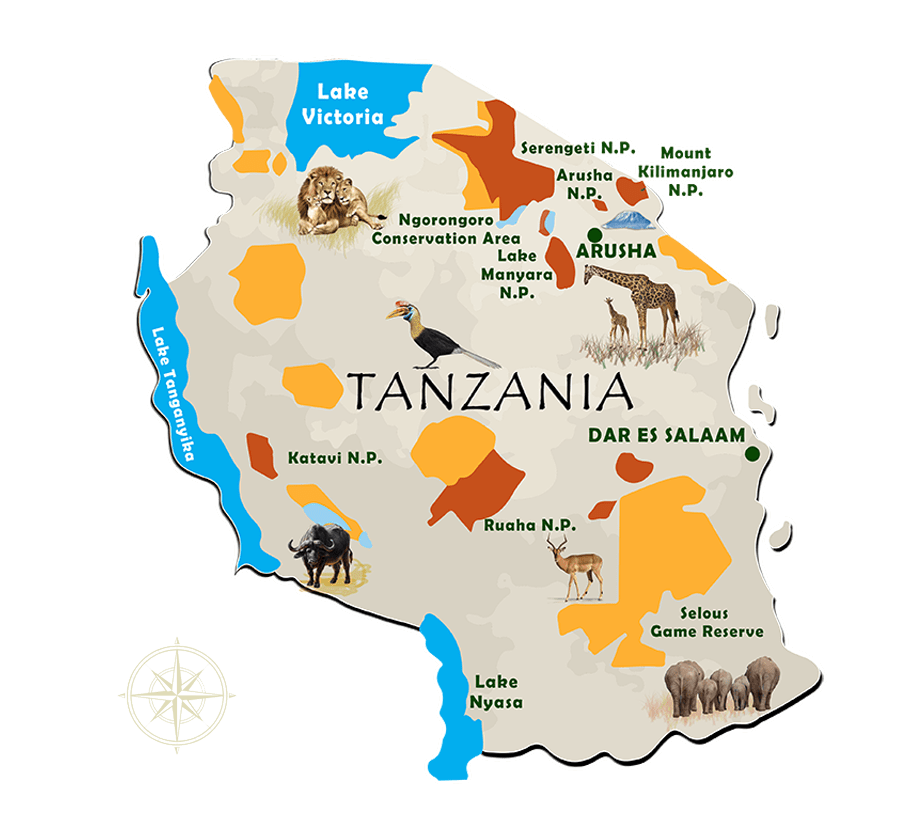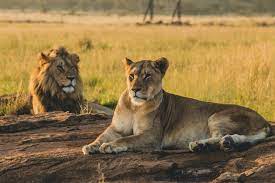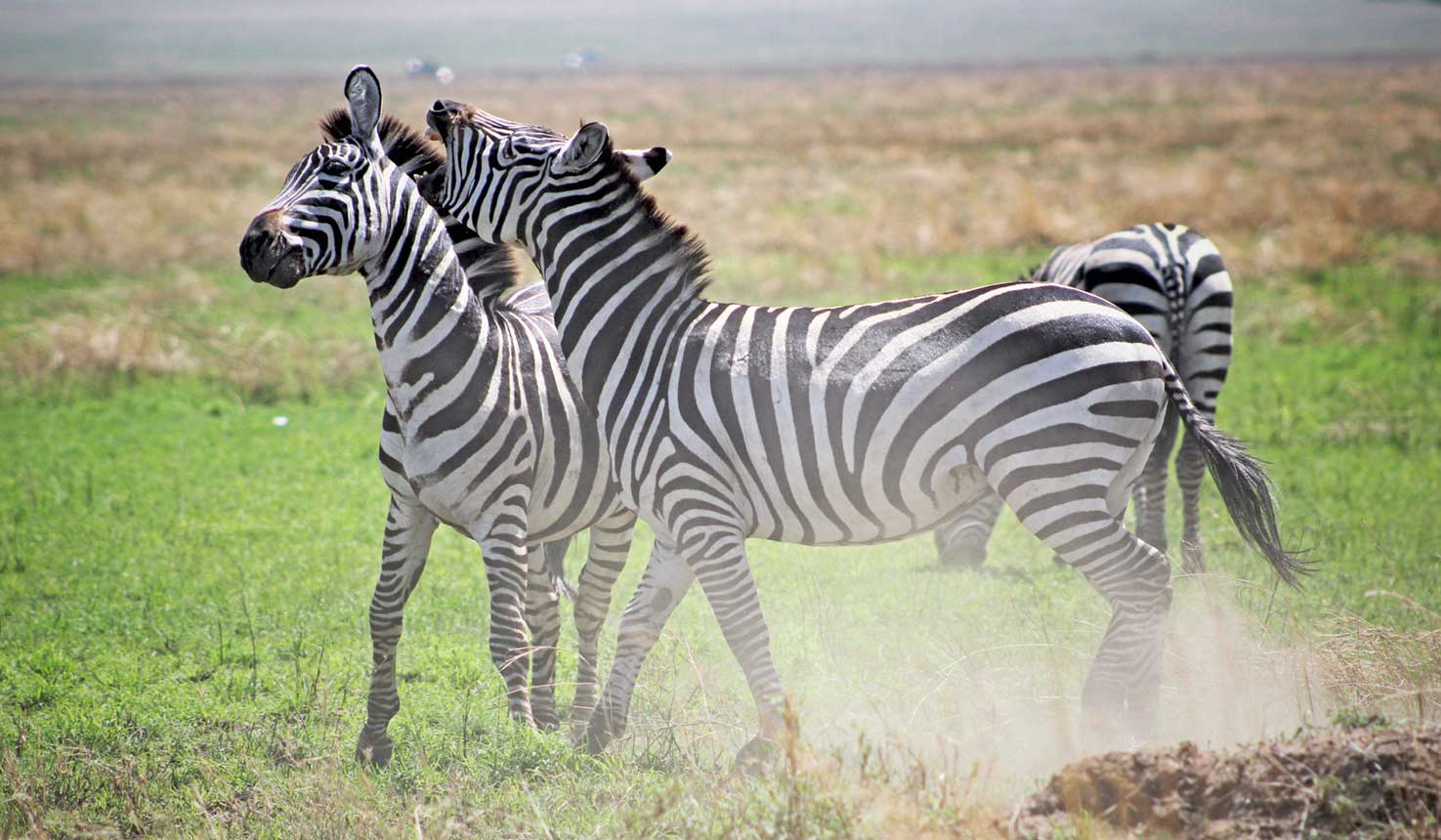
Southern Tanzania

3,230 km²

Savannah and Woodland

Abundance of Wildlife and Scenic Views of the Uluguru Mountains
Mikumi National Park is renowned for its diverse wildlife and captivating landscapes. Unlike the Great Migration, which is a well-known spectacle in other parts of Tanzania, Mikumi offers an equally thrilling experience with an abundance of wildlife year-round. Visitors can spot elephants, lions, giraffes, zebras, and an array of bird species as they roam freely across the park’s expansive terrain.
Mikumi covers an area of 3,230 square kilometres (1,247 square miles), offering vast plains, miombo woodlands, and seasonal wetlands. The park is often compared to the Serengeti in terms of its open spaces, with its scenic beauty capturing the essence of East Africa’s wilderness. Majestic baobab trees dot the landscape, adding to the park’s natural charm, while rolling grasslands and dense woodlands provide diverse habitats for wildlife. Visitors to Mikumi are treated to stunning panoramic views, making it an ideal destination for those seeking a tranquil and immersive safari experience.
The Mkata River, flowing through the heart of Mikumi, creates a unique ecosystem that attracts a wide variety of animals. During the dry season, the river’s banks become a hub for wildlife, as animals gather to drink and cool off. The nearby wetlands are home to hippos, crocodiles, and a variety of bird species, making it an excellent spot for birdwatching. The interaction between the wildlife and these water sources provides an unforgettable safari experience, especially in the hotter months when the animals congregate in these areas.
While Mikumi is easily accessible and less crowded compared to Tanzania’s more famous parks, it offers plenty of opportunities for private and secluded safaris. The park is adjacent to Selous Game Reserve (now Nyerere National Park), providing visitors with options for exclusive safari experiences in the nearby reserves. Luxury camps and lodges, along with mobile safari options, allow for a more intimate connection with nature, offering a peaceful and private safari experience away from the crowds.
The central region of Mikumi, particularly around the park’s main entrance, is known for its excellent wildlife sightings. Visitors can often see herds of elephants, impalas, buffaloes, and lions in close proximity. This area also provides easy access to the park’s most scenic spots. For those seeking a quieter experience, the park offers numerous less-visited areas where wildlife is just as abundant. Exclusive safari lodges and luxury tented camps can be found in these quieter sections, allowing for a peaceful, personalized safari adventure in one of Tanzania’s most scenic parks.
Mikumi National Park offers one of Tanzania’s most captivating and immersive safari experiences. Its vast plains, lush woodlands, and diverse wildlife create a haven for nature lovers and wildlife enthusiasts. The park’s stunning beauty, with its open savannahs bordered by mountain ranges, sets the stage for unforgettable wildlife encounters. One of my most memorable moments was watching a herd of elephants grazing near the Mkata River, with the backdrop of distant hills, a serene and awe-inspiring sight.

Travel Designer
Browse through some of the finest accommodation options

However, we’ll plan your safari around your interests, tastes, and preferences. In addition, we provide honest advice based on first-hand knowledge. Moreover, our goal is to ensure that every aspect of your journey reflects what you truly enjoy. Therefore, you can expect a customized experience that caters specifically to your desires. Furthermore, our expertise will guide you in making the most informed decisions. Ultimately, this approach guarantees a memorable and fulfilling travel experience, ensuring exceptional service, personalized attention, and unique opportunities for adventure.

However, our expert guides and brilliant concierges are hand-picked for their ability to bring your destination to life with care and passion. Furthermore, their extensive knowledge and enthusiasm ensure that every moment of your journey is enriched with local insights. Moreover, they are dedicated to providing an exceptional experience tailored to your preferences. As a result, you can fully immerse yourself in the destination and enjoy a truly unique adventure. Ultimately, their commitment transforms your trip into an unforgettable exploration of the world.

But, we seek out unforgettable experiences that benefit both local communities and the environment. By doing so, we ensure that your adventures not only create lasting memories but also positively impact the places you visit. Additionally, our focus on sustainability and community support helps preserve the natural beauty and cultural heritage of the destinations. Ultimately, this approach allows you to enjoy your journey while contributing to the well-being of both people and the planet, ensuring sustainability, cultural respect, and environmental preservation throughout your travels.
Hence, get inspired by our example trips, and then reach out to plan your adventure. Whether you have specific desires or need guidance, our team of expert travel designers is ready to help. Additionally, we tailor each trip to meet your unique interests and preferences. Therefore, you can be assured of a personalized and exceptional travel experience. Ultimately, we are here to make your dream journey a reality.
Therefore, whatever you want from your tours, our team of expert travel designers are ready to help.

Home Made For You Highlights Where to stay Trip inspiration Where to go When to visit Inspiration Location Area 988 km² Ecosystem Coral Reefs Unique Feature Spice Farms Experience a Tropical Escape on Pemba Island…
All Destination Mount Kilimanjaro Climbing National Parks,Mountain Range 1668 km² Northern Circuit, Kilimanjaro Book OverView Highlights Activities FAQ Safari Packages Parks Nearby Mount Kilimanjaro National Park National Parks,Mountain Range 1668 km² Northern Circuit, Kilimanjaro Mount…
All you need to know about Kilimanjaro National Park Reading time: 6 minutes Oct 16, 2024 A Treasured Landmark The Park is one of Tanzania’s most treasured landmarks and a top destination for visitors. Discover…
Home Made For You Highlights Where to stay Trip inspiration Where to go When to visit Inspiration Location Area 70 meters (approx.) Ecosystem Lush Tropical Forest Unique Feature Coffee Tours Nearby Experience a Refreshing Adventure…
Home Made For You Highlights Where to stay Trip inspiration Where to go When to visit Inspiration Location Area 1,510 km² Ecosystem Savanna and riverine forests Unique Feature The Great Migration Experience a Thrilling Safari…
Where History Meets Exotic Beaches Welcome to Sun, Sand and Spice Zanzibar Island: A Tropical Sanctuary Nestled off Tanzania’s coast in the warm waters of the Indian Ocean, Zanzibar Island provides an unparalleled experience for…
Home Made For You Highlights Where to stay Trip inspiration Where to go When to visit Inspiration Location Area 1,990 km² Ecosystem Montane and tropical rainforests Unique Feature Stunning waterfalls, including the Sanje Falls Experience…
The Land of 1000’s of Elephants Welcome to Home to the Elephants Tarangire National Park is renowned for its majestic Baobab trees, which can grow to an enormous size and boast a unique, iconic shape….
Home Made For You Highlights Where to stay Trip inspiration Where to go When to visit Inspiration Location Area 1,100 km² Ecosystem Coastal and Savannah Unique Feature Beach and Wildlife Combination Experience a Thrilling Safari…
Home Made For You Highlights Where to stay Trip inspiration Where to go When to visit Inspiration Location Area 456 km² Ecosystem Forest and Lake Shore Unique Feature boat safaris and primate sightings. Experience a…
Home Made For You Highlights Where to stay Trip inspiration Where to go When to visit Inspiration Location Area 14 km² Ecosystem Coastal and mangrove forests Unique Feature Historical Swahili architecture and pristine beaches Experience…
Home Made For You Highlights Where to stay Trip inspiration Where to go When to visit Inspiration Location Area 30,893 km² Ecosystem Miombo woodlands, savanna, rivers Unique Feature The Rufiji River and boat safaris Experience…








The best time to visit Mikumi National Park depends on what kind of experience you’re looking for. The dry season, from June to October, is perfect for wildlife viewing. During this period, animals tend to congregate around the Mkata River and other water sources, making it easier to spot them. The weather is also more pleasant, with less rainfall and comfortable temperatures, making it ideal for game drives. This is the peak time to observe the park’s abundant wildlife, including elephants, lions, giraffes, and zebras.

June-October

November to May
Whatever you want from your adventure in the Tanzania, our team of expert travel designers are ready to help


Therefore, when you book a safari in today’s world, there is much to consider. However, with the right advice and expert planning, you can confidently approach your travel arrangements. Additionally, our experienced team is here to provide guidance. In other words, we ensure that every detail is handled smoothly.
Moreover, if you book to travel with us, your plans are impacted by circumstances beyond your control, then we understand that flexibility is essential. Consequently, we offer options to adjust your reservation or cancel it. As a result, you will receive full credit for future travel expenses. Thus, you can plan your next adventure without worry.
Mikumi National Park is known for its diverse wildlife, including elephants, lions, giraffes, zebras, and a wide variety of bird species. It is one of the most accessible parks in Tanzania, offering a classic safari experience with expansive plains, miombo woodlands, and wetlands.
The best time to visit Mikumi is during the dry season, from June to October, when animals gather around water sources, making wildlife viewing easier. For those interested in lush landscapes and birdwatching, the green season from November to May is also a great time to visit, though it comes with more rainfall.
Mikumi National Park is easily accessible by road from Dar es Salaam, approximately a 4-5 hour drive. There are also chartered flights to Mikumi from Dar es Salaam and other nearby airports. Many safari tours include transportation to and from the park.
Mikumi is home to a wide range of wildlife, including elephants, lions, leopards, buffalo, giraffes, impalas, and zebras. The park is also great for birdwatching, with over 400 bird species, including storks, ostriches, and various waterfowl.
Yes, Mikumi offers various accommodation options, including luxury lodges, tented camps, and budget-friendly choices. Many of these accommodations are located within or near the park, offering easy access to safari activities.